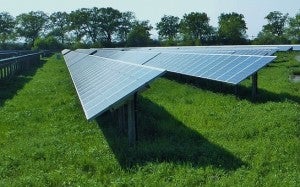5 Reasons Virtual Net Metering is Better than Plain Ol’ Net Metering
 Several states have embraced net metering in order to encourage the adoption of solar energy and other distributed generation. Sometimes referred to as “running a meter backwards,” net metering allows people to generate their own electricity, export any excess electricity to the grid, and get paid for providing this excess energy to the utility who may use it to power nearby homes or manage overall electricity demand.
Several states have embraced net metering in order to encourage the adoption of solar energy and other distributed generation. Sometimes referred to as “running a meter backwards,” net metering allows people to generate their own electricity, export any excess electricity to the grid, and get paid for providing this excess energy to the utility who may use it to power nearby homes or manage overall electricity demand.
Net metering leads to lower – or in some cases negative – electricity bills without having to invest in expensive batteries to store excess energy, which can be cost-prohibitive. By generating energy on-site where it’s consumed, net metering also reduces the strain on distribution systems and cuts the amount of electricity lost to long-distance transmission and distribution (estimated at seven percent in the U.S.). Net metering, moreover, tends to reduce greenhouse gas emissions by incentivizing people to adopt renewable energy and become more aware of energy-saving opportunities.
A few states like Illinois are now talking about “virtual” net metering. The term “virtual” may be confusing, but it essentially means customers can receive net metering credits for projects even if they are not on their property. An example would be a group of neighbors receiving such credits for a community solar project.
Virtual net metering offers many advantages, even over its more common cousin, including:
1. Optimized siting for solar and distributed energy projects
Rather than being limited to a single roof that might be tilted away from the sun or covered by trees, installers, investors, and customers can choose the most productive sites, making for a better investment with higher financial returns.
2. Additional financing options, plus options for renters
A “virtual” project also enables creative project financing, perhaps through crowd funding or third-party ownership. It also allows renters and other non-homeowners to invest in energy projects. For example, California’s Multifamily Affordable Solar Housing (MASH) Program has led to 20.5 megawatts of solar capacity interconnected across 323 projects that serve 6,371 affordable housing tenant units.
3. Economies of scale, which lower costs
Virtual net metering enables larger project developments, while also minimizing costs associated with house alterations and project maintenance. Larger projects allows for an economy of scale which lowers costs for everyone involved (i.e. the greater the quantity of a good produced, the lower the per-unit fixed cost because these costs are shared over a larger number of goods). The Lawrence Berkeley National Laboratory (LBNL) calculated that the installed cost of solar drops over 30 percent when moving from a 2 kilowatt system to a 10 kilowatt system. Economies of scale also may allow investors and developers to target construction on cheaper property areas, the value of which may vary widely within a utility service territory, further adding to a project’s financial incentive.[Tweet “By adding “virtual” to net metering, we can expand the benefits of solar energy projects to more people http://ow.ly/DAjAL”]
4. Expedited project development
Virtual net metering can streamline the interconnection application and review process for both utilities and customers. Compared to applications from multiple residents with rooftop solar, a community project would require a single filing, saving both time and money.
5. More profitable compensation rates
Virtual net metering, particularly for solar projects, allows more customers – not just those with solar panels on their roofs – to take advantage of a utility’s dynamic retail electricity rates that offer higher prices during peak periods in warm summer months, which coincide with maximum solar electricity production.
By adding “virtual” to a tried-and-true concept, we can expand the benefits of solar and other clean distributed-generation projects to more people. This expansion also offers “real” reductions in both costs and pollution.











